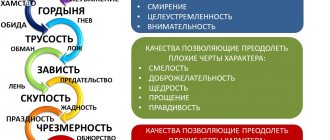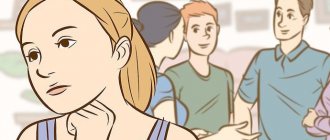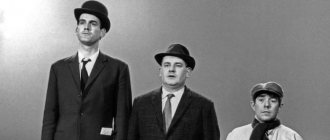How individual psychological characteristics of a person manifest themselves
Psychology studies the general and individual laws of formation and development of the psyche. By the way, they are studied not only by psychology, but also by philosophy and sociology. The first (general patterns), for example, includes the theory of age-related crises, the concept of psychological defense mechanisms. The second is ideas about the formation of individual psychological characteristics. What applies to them? Individual psychological characteristics of a person include temperament, character and its individual traits, abilities, and emotional-volitional sphere.
How and in what ways are individual psychological characteristics manifested? Yes in everything. For example, how we react to certain events or how we tell a story is directly related to temperament. Choleric people give in to emotions and gesticulate a lot. Phlegmatic people are reserved, pay attention to little things, and objectively assess the situation. However, we have already gotten a little ahead of ourselves. Let's look at each of the main individual characteristics in more detail, including temperament.
Interesting! The study of individual psychological characteristics deals with a special branch of psychology - differential psychology, or the psychology of individual differences. It explains why people behave differently in the same situations, why children with completely different futures grow up in the same conditions, etc.
Habits of successful people
Having examined the behavioral characteristics of many celebrities, we were able to conclude that they have similar habits that largely contributed to the achievement of the result:
- Early rise every day.
- Planning each next day, regardless of whether it will be a working day or a rest day. Aimless existence destroys personality.
- Multitasking is not for a leader. The simultaneous execution of several processes often leads to the fact that none is completed. Set no more than 3 goals a day and consistently achieve them.
- Sport keeps you active, increases self-esteem, and has a positive effect on health.
- Correctly set priorities and an understanding that rest and work should coexist in harmony give strength to make decisions on everyday life. Time spent with family on weekends, doing what you love, and going for walks are useful activities that contribute to personal development.
- 20 minutes of silence daily. This is the period that allows you to sort out the accumulated information and comprehend it.
- Weekly analysis of actions helps to identify shortcomings that can be corrected in a short time.
- Charity is a mandatory activity for wealthy people. True, each of them pursues their own goals here.
- Planning. Businessmen build a schedule for the week, forming goals and expected results.
Today, the division by gender has disappeared, but despite this, it is more difficult for women to reach heights in their careers and occupy leadership positions. For some, this is an obstacle; a strong personality will regard this situation as a challenge and will strive to overcome it. There is a choice of professions to which men do not have access.
Temperament
Temperament is a type of nervous system, an innate characteristic. This is a set of psychophysical properties of a person that determines the specifics of performing an activity. Rhythm, speed, intensity of reactions - all this depends on temperament. Let's take a closer look at the types of temperaments, and then their properties.
Types of temperament according to Hippocrates
Hippocrates was the first to talk about temperaments. He identified four personality types based on which fluid predominates in a person:
- Holi (bile). These are active and sometimes fussy people. They are characterized by sudden mood swings and sociability, turning into obsession.
- Phlegm (mucus). These are calm, reasonable, slow people.
- Melan holi (black bile). These are pessimists, in a state of decline and characterized by indecision.
- Sangwa (blood). These are active and persistent people who always achieve their goals. Born leaders.
Since then, many studies have been carried out, different classifications of temperaments have appeared, but this typology is still taken as a basis. True, no one talks about the predominance of liquids anymore, and the names have changed a little. The study of temperaments is conducted around the reactions of excitation and inhibition. And the main person in this theory is considered to be I.P. Pavlov.
Temperament in modern psychology
In modern psychology, the following classification of temperaments is used:
- Choleric. Strong, agile, unbalanced type. They say about these people: “Starts with half a kick.” True, the choleric person cools down just as quickly. Moreover, he not only cools down, but forgets the reason for the quarrel, the unpleasant fact itself. Therefore, it is difficult to resolve disagreements with choleric people. Cholerics have leadership qualities, but lack of restraint and emotionality prevent them from achieving a stable result in life.
- Sanguine. Agile, balanced, strong type. The processes of excitation and inhibition occur quickly, but this does not affect the mood as clearly as in a melancholic person. Sanguine people are more into humor. They can be called easy-going. They are distinguished by high adaptive abilities, flexibility, and sociability. These are positive and active people who know how to find an approach to every person and have leadership characteristics. A sanguine person does not tolerate boredom and monotony. It is characterized by high speed and strength in performing activities.
- Phlegmatic person. Strong, balanced, motionless type. The arousal reaction is weak. Phlegmatic people are distinguished by restraint and prudence, which sometimes turn into tediousness. These are the executive and most responsible workers, but living with a phlegmatic person is difficult. He is stingy with emotions, does not know how to empathize, is cautious and passive. Does not like surprises, experiments, novelty. His restraint, resistance to stress and composure are sometimes mistaken by others for indifference. Phlegmatic people do not like changes in activity.
- Melancholic. Weak, unbalanced, mobile type. Like a choleric person, his mood constantly fluctuates, but negative connotations predominate. This is a passive, insecure, vulnerable type. Gets tired quickly and does not adapt well to changes. At the same time, these are the most sincere and empathetic people with a rich and interesting inner world.
Psychologists note that not a single temperament occurs in its pure form. That is, more often a person has 2 or 3 types mixed.
In addition, modern psychology relies on the typology of temperaments by K.G. Cabin boy. He identified two types: extroverts and introverts. The former direct their energy to the outer world, the latter to the inner world. Extroverts have a more acute need for social contacts and group work than introverts. The latter are prone to solitude. This is due to the fact that introverts have a higher sensitivity to external stimuli. Extroverts are more stable, so they need strong emotional influences to be aroused.
Interesting! There are other typologies of temperaments, for example, Galen’s classification, the theory of E. Kretschmer.
Properties
Balance, mobility, strength are properties of temperament. We have already mentioned this, but there are other properties. Let's look at them in more detail:
- sensitivity (sensitivity) – reaction to minimal exposure to a stimulus;
- reactivity - the strength of the emotional reaction to stimuli;
- activity – activity in interpersonal relationships, when performing activities;
- pace of reactions - speed of movements, speech, thinking, performance of activities;
- mobility (plasticity/rigidity) – speed of adaptation to changing conditions.
Let’s imagine portraits of temperaments through a table, where “+” is a high level, and “–” is a low level of some property.
| Sensitivity | Reactivity | Activity | Rate of reactions | Mobility | |
| Choleric | – | + | + | + | + |
| Sanguine | – | + | + | + | + |
| Phlegmatic person | – | – | + | – | – |
| Melancholic | + | – | – | – | – |
In addition, when considering temperaments, it is customary to study concentration. Choleric people have slow concentration (distractable type), sanguine people have fast concentration, phlegmatic people have slow concentration, melancholic people have unstable attention (they get tired quickly, are distracted a lot).
Important! Characteristics of temperament must be taken into account during the learning process, during employment and when building relationships with others. The psychological climate in the family, work team, class, group depends on the compatibility of temperaments.
Character
Character is a complex of acquired personality traits. Don’t believe those who say: “That’s my character” or “We don’t get along.” Unlike temperament, character can be changed.
First, let's define the concept. Character is a complex of stable personality properties that determine a person’s behavior and reactions and his attitude towards other people and himself. Now let's look at several character classifications.
Classifications
S. Freud, within the framework of his theory of psychosexual personality development, identified the following types of character:
- Oral. This is an irritable person prone to overeating, alcohol abuse, smoking and other addictions. Among people of this type there are representatives of two subspecies: passive-oral and oral-aggressive. The first are distinguished by naivety, suggestibility, and knowledge. The latter are characterized by cynicism, often show aggression, crave power, and tend to manipulate people.
- Anal. These are overly pedantic, secretive people prone to hoarding. As with the oral character, there are two subtypes: anal-retentive and anal-thrust. People of the first type are distinguished by greed and stubbornness. People of the second type are characterized by emotional instability and an aggressive desire for leadership.
- Phallic. People of this type try to demonstrate their masculinity/femininity as much as possible in everything. And not in the best forms: impudence, bitchiness, depravity. These are people of extremes. They either hate themselves or they adore them; or remain faithful, or regularly engage in casual relationships; or are overly cautious, or lead a wild and dangerous lifestyle, etc.
- Genital. According to Freud, this is the optimal, healthy type of character. He is characterized by a high level of stress resistance, developed adaptive abilities, sociability, openness, and activity. Such people achieve success in all areas of life and know how to win people over.
Another psychoanalyst, Alexander Lowen, named these types of characters:
- Oral. These are people who depend on other people's opinions and are afraid of being rejected and abandoned. Every minute they demand attention to themselves, waiting for words of love. However, they do not know how to give off heat.
- Masochistic. These are secretive, distrustful and vindictive people, prone to self-punishment and self-flagellation. They are used to playing the role of a victim and suffering. Those who find themselves next to them become unwitting participants in some kind of drama.
- Hysterical. These are very artistic people. They do not live, but play on stage. Their every word, reaction, gesture is clearly verified and rehearsed. However, excessive emotionality prevents you from making and implementing long-term plans. Such people need emotions, so they constantly get into some kind of trouble, become participants or instigators of scandals and fights.
- Narcissistic. These are people who are guided solely by personal interests. People for them are tools, a means to achieve personal goals. A narcissist does not know how to empathize or sympathize. He asserts himself at the expense of others. He cannot stand loneliness, as he needs to see, hear and feel admiration for himself.
- Schizoid. People who live in their own world. Outwardly it seems that they are cold, callous, indifferent. But that's not true. Passions boil in the inner world of a schizoid; he knows how to love and get carried away by something. But he does not tolerate “water” or anything superficial. Carefully chooses friends, hobbies, and work.
I believe you have noticed that characters get their names from a set of individual, leading qualities. Therefore, sometimes character types are called accentuation types. But let's look at this separately.
Note! There are no bad or good characters. Each person has their own advantages and disadvantages.
Accentuations
Accentuations are sharpened character traits. That is, this is some kind of disharmony, in which some features are weakly expressed, while others are overdeveloped.
In psychology, it is customary to focus on the typology of accentuations proposed by A.E. Lichko:
- Hyperthymic type. These are resourceful, active and sociable people. They will make their way everywhere, however, problems arise with long-term planning. Risk-prone, rarely think about the consequences of their actions.
- Cycloid type. The life of such people consists of cycles: sometimes a good mood, sometimes a bad one, activity is replaced by passivity, a period of increased performance turns into a period of loss of strength, etc. If you communicate with this person occasionally, you may get the impression that you are dealing with different people. One phase of the cycle lasts 2–4 weeks.
- Labile type. Unpredictable and emotionally unstable type. Your attitude towards yourself, other people and the world is directly related to your mood. Increased sensitivity to external stimuli is noticeable.
- Asthenoneurotic type. An anxious, capricious, lethargic type, prone to hypochondria - excessive preoccupation with one's own health. Such people quickly get tired of work, communication and other activities.
- Sensitive type. These are sensitive and impressionable people. They prefer solitude, calm and quiet games, and “one-on-one” hobbies. In the presence of close people they behave relaxed, but in a circle of unfamiliar people they are reserved and indecisive.
- Psychasthenic type. These are anxious, suspicious, indecisive people, prone to philosophizing. They get tired quickly and suffer from mood swings. They often withdraw into themselves.
- Schizoid type. These people build an invisible wall between themselves and the world. They do not express the need for social contacts; they are happy alone. These are stubborn and purposeful people who do not like to pour water. The essence of things is important to them, not the form. Actions are preferred to words.
- Epileptoid type. This is a passive, inflexible type who is prone to affective outbursts. Moreover, in this case, the affect lasts quite a long time – up to several days. All this time the person is in a depressed mood and is looking for someone to take his anger out on. Epileptoids can be dangerous to others and are capable of violence during an outbreak.
- Hysterical type. Such people are characterized by egocentrism. They are indifferent to the problems and interests of others and crave constant attention to themselves. Prone to manipulation and blackmail, including demonstrative attempts at suicide.
- Unstable type. People of this type do not like to work, they try to escape from reality and responsibility into the world of entertainment and games. They cannot be alone. In companies they occupy the position of slaves.
- Conformal type. People of this type are afraid of novelty and do not perceive it in any form. They become attached to things, people, work, order, etc. They take a long time to get used to a new environment and have difficulty adapting to any changes in life. In a group, people are more likely to be followers than leaders.
You may have been confused by some of the names, as they are very similar to the names of mental disorders. Don't be alarmed. Accentuation is not a pathology. However, it cannot be considered normal either. This is a borderline state between the norm (a harmonious character in which all traits are balanced and compensate for each other) and pathology (psychopathy). Accentuations need to be monitored and, if possible, corrected, since under the influence of unfavorable factors they can turn into pathology.
Structure
Character structure is a group of leading traits. There is no generally accepted classification in psychology, but the following character structure can be roughly distinguished:
- emotional traits - cheerfulness or gloominess, sensitivity or callousness;
- volitional traits - decisiveness and indecisiveness, independence and dependence, initiative and passivity;/li>
- moral traits - kindness and cruelty, responsiveness and indifference, sincerity and deceit;
- intellectual traits - curiosity or indifference, intelligence or dullness, resourcefulness or confusion.
In everyday life, there are many unofficial names for characters: weak-willed (a rag), steely-willed (a man with a core), no character (a “neither fish nor fowl” person). All this has to do with character structure. That is, those around you notice which group of traits is expressed more strongly or weakly and, based on this, they give the name to the entire character. For example, the core refers to developed volitional qualities.
Character traits and temperament properties
The first character traits based on temperament appear already in infancy, and by adolescence many of them become stable. At the same time, the relationship between character and temperament manifests itself in all aspects of a person’s life, forms the principles of his behavior, dictates interests, desires and actions.
Manifestations of character can be expressed in relation to oneself and the people around you. Tactfulness or rudeness, the desire to help loved ones or unwillingness to see other people’s difficulties, stable attachment or the ability to easily part with people determine the characteristics of a person’s communication.
Other character traits show his attitude:
- towards oneself - self-confidence or a tendency to self-flagellation;
- to the point - conscientiousness and responsibility or a tendency not to go into details and always rush;
- to things - neatness or negligence, respectful or not very respectful attitude towards other people's property and cultural values.
Character traits lay down behavior programs. And if the program is formed, this is exactly how a person will act in typical situations. Moreover, in childhood and adolescence, these “programs” are amenable to external adjustment - through the efforts of educators, teachers, parents, and psychologists. In adulthood, a person, as a rule, tends to follow accepted programs of action and change them only if he understands that they interfere with achieving his goals.
Capabilities
Abilities are innate data. To be more precise, from birth we are given inclinations, and in the future it depends on the conditions of human development whether they develop abilities or not. Inclinations are anatomical and physiological features of the nervous system that serve as the basis for the formation of abilities. Abilities are personality traits that help one achieve greater success in performing any activity compared to other people.
Abilities can be biologically determined (given by nature) and socially acquired (specific abilities). In addition, in psychology it is customary to distinguish the following types of abilities:
- Are common. They help you achieve success in any type of activity. Examples of general abilities: good memory, high stability of attention and mental agility.
- Specialized. Increase the chances of success in mastering a specific activity. Examples: musical ear, artistic taste.
Among the special abilities are the following types:
- musical,
- artistic,
- sports,
- literary,
- creative,
- educational,
- intellectual,
- mathematical,
- others.
On the subject of interaction, it is customary to distinguish the following abilities:
- interpersonal – a person easily establishes social contacts;
- subject - a person is better able to interact with objects than with people.
In addition, theoretical and practical abilities are distinguished. In the first case, a person is more inclined to analysis and reasoning. In the second case, a person prefers to implement his activities through active actions.
According to the degree of development, abilities are reproductive (repeating someone else’s experience, knowledge) and inventive (creating something unique, new).
Structure of individual qualities
To more accurately determine the quality of a person’s personality, one should highlight its biological structure. It consists of 4 levels:
- Temperament, which includes characteristics of genetic predisposition (nervous system).
- The degree of unique mental processes that allows one to determine a person's personal qualities. The level of individual perception, imagination, manifestation of volitional signs, feelings and attention influences the achievement of results.
- The experiences of people, characterized by knowledge, abilities, capabilities and habits.
- Indicators of social orientation, including the subject’s attitude to the external environment. The development of personal qualities acts as a guiding and regulating factor of behavior - interests and views, beliefs and attitudes (state of consciousness based on previous experience, regulating the attitude and behavior of people), moral norms.
The above categories are closely related to the needs and character, abilities and egocentrism of people. The set of general indicators influences the creation of an individual personality shell.
Emotions
Emotions are a mental reaction to any events. An emotional reaction is always subjective and has nothing to do with objective facts. Emotions are associated with the individual needs of the individual, as well as beliefs and experiences.
By type, emotions can be positive or negative. The first includes joy, passion, enthusiasm, faith, optimism, hope, satisfaction. The second - boredom, irritation, disappointment, anxiety, despondency, fear, sadness, excitement.
Psychologist B.I. Dodonov proposed the following classification of emotions according to the specifics of the situations in which they arise:
- communicative;
- altruistic;
- practical (occurs after the successful implementation of the plan);
- gloric (associated with the need for self-affirmation);
- fearful (occurs in situations of risk, danger);
- romantic;
- aesthetic;
- Gnostic (associated with the desire for knowledge);
- active (associated with accumulation, gathering);
- hedonistic (associated with any pleasures).
Emotions are situational experiences. They are short-lived. If you continue to experience the same thing after the situation ends, then this is the feeling. However, in practice, the first and second are often identified.
Will
Will is a person’s ability to consciously regulate his behavior and activities. The presence of will presupposes overcoming external and internal obstacles on the path to the goal. The will is formed by the age of 5-6 years. Until this moment, the child has only involuntary activity. But gradually the child learns to structure his motives and desires, overcome difficulties, and analyze his thoughts and actions.
Will is manifested in such character traits as perseverance, determination, dedication, independence, courage, endurance, diligence, and discipline. The presence of these qualities is noticeable at the cognitive, emotional and behavioral level.











